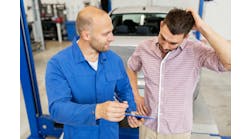Collision repairers have sought clear repair guidelines to follow for years. Having specific processes to follow and standards to uphold would improve repair quality, shop-insurer relations and consumer satisfaction. But to date, no such guidelines exist.
Industry professionals are working to change that. Several prominent collision repair organizations release_notesd a joint statement during the November 2011 Collision Industry Conference (CIC) meeting, declaring original equipment manufacturer (OEM) repair processes as the industry’s standard. Among those organizations were the Automotive Service Association (ASA), Society of Collision Repair Specialists (SCRS), Alliance of Automotive Service Providers (AASP) and the Assured Performance Network (APN).
The announcement was meant to serve as a baseline for the establishment of training, testing, repair practices and documentation in the collision repair industry, and to provide a foundation and focus for repair standardization. Many repairers already consider OEM procedures as the standard, but this marked the first official declaration by any established organization.
Nick Kostakis, owner of Angelo’s Auto Body Inc. and spokesman for the AASP, says it’s quickly becoming more critical than ever to create continuity in the way repairs are made. The adoption of standards will better define the difference between proper and improper repairs, and motivate shops to further invest in equipment and training.
“Shops doing poor quality work may find it harder to hide in the presence of well-established standards,” Kostakis says. “And quality-oriented repairers may find it easier to get paid for proper repairs.”
This isn’t the first attempt that has been made to develop repair standards for the collision industry. The CIC is currently researching the possibility of establishing a new organization, the United States Collision Repair Standards Institute (USCRSI), to oversee standard development.
Kostakis says the organizations that made the joint OEM standard declaration do not fully agree with the CIC’s efforts. In the past, the CIC limited its activities to the study of issues, and the generation of “best practices” documents. But the proposal to create a separate, formal organization is significantly different.
Aaron Schulenburg, executive director of the SCRS, says there are existing organizations that are capable of managing the standards effort, rather than overburdening the industry with another entity that necessitates funding and financial support.
The next step is to understand whether most industry stakeholders agree that OEM procedures should be accepted as the basis for standards. Since the official announcement last November, 22 additional repairer organizations nationwide expressed support.
Industry entities that support OEM repair guidelines as the basis for standards agree there would still be major issues necessary to address. For example, not every OE manufacturer publishes all procedures, and there are parts issues that come into play.
So the declaration called on I-CAR for assistance. I-CAR was asked to create a council composed of industry stakeholders to identify gaps in OEM repair information, work with OEMs to ensure that their published procedures are robust and conclusive, and that repair facilities have easy access to the information.
Ron Pyle, president of the ASA, says I-CAR was the obvious organization to take this on because it is neutral, trustworthy, and already provides education and training for repairers.
Pyle says the organizations that made the declaration are waiting to hear whether I-CAR decides to get involved before additional action is taken.


